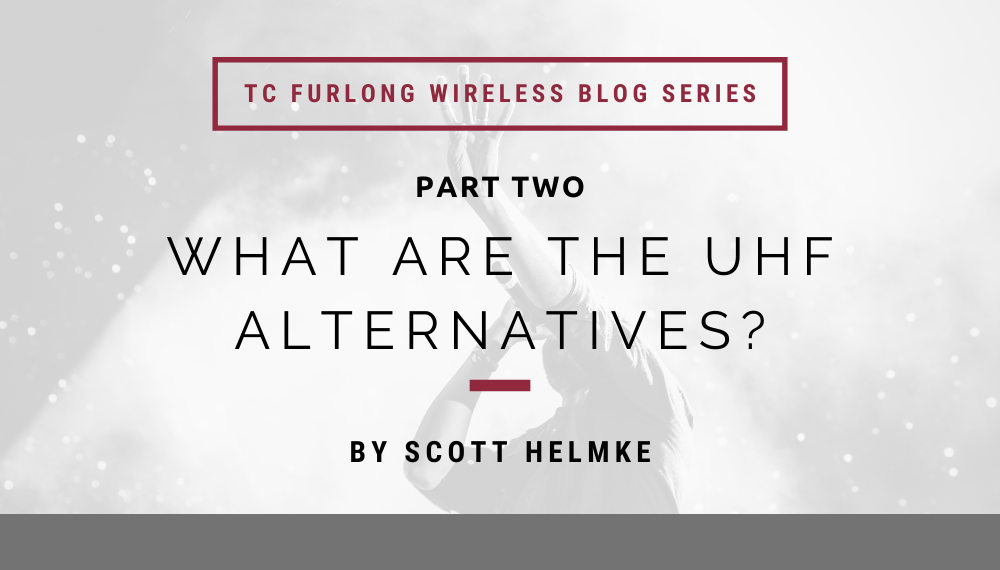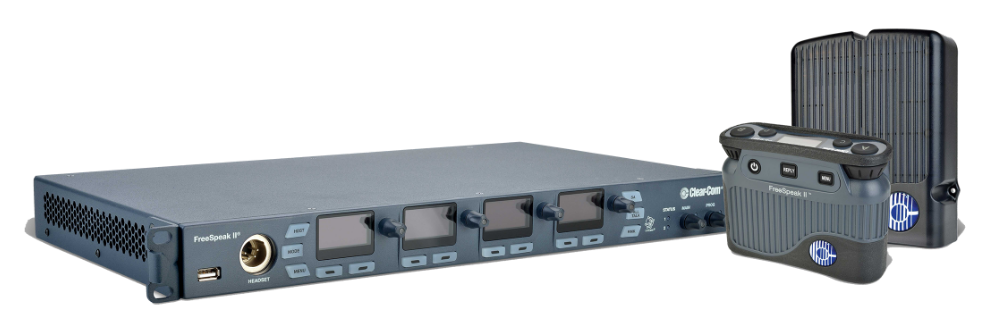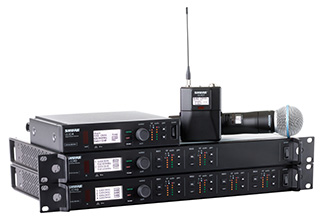
by Scott Helmke
This blog post is the second entry in an ongoing series all about wireless systems – background info, best practices, and useful tips & tricks. Click here to check out the previous article and get caught up.
In the previous blog post I wrote about using production wireless systems in the unused gaps between TV stations in the UHF band, and how we’ve lost a lot of the spectrum that we used to take for granted. The obvious next question is “is there any other spectrum available for production wireless?”
The answer is generally yes, although there isn’t a lot of spectrum lying around empty and available for us to use.
VHF
The two VHF frequency bands (88-108MHz and 174-216MHz) are available aside from avoiding TV stations. However, using those lower frequencies usually means larger antennas are needed. Also, there are some other sources of interference which could cause problems. RF noise radiating from unshielded network cabling (and almost all Cat5/Cat6 cabling is unshielded) is much more of an issue in the VHF band than in UHF. I have also seen LED stage lighting to cause a lot of noise in the VHF band, even in cases where UHF microphones were not affected. Interestingly, it also appears that modern digital TV works better in UHF than VHF, and so nobody is in a hurry to start a new DTV station in the VHF spectrum.
As far as VHF products go, Shure manufactures a VHF version of their ULXD microphone systems, including VHF antennas. Radio Active Designs makes the UV-1G wireless stage intercom system which uses a proprietary AM technology to fit a large number of frequencies into the VHF band. And if you’ve still got some old VHF relic that still works, it’ll probably still function just as well as it ever did. TC Furlong Inc. has ULXD in both UHF and VHF bands available for rentals, as well as a RAD UV-1G wireless intercom system.
2.4GHz
A popular frequency band for inexpensive microphone systems is the 2.4GHz WiFi band. A large number of products are available for this band, usually marketed for amateur uses. This frequency band is often usable for one or two channels of wireless audio, but rarely more than that simply because of the limited amount of space available and because it is shared with many other devices. This can be a risky place to put wireless microphones, because you usually don’t see much interference until the audience shows up and starts using the WiFi on their phones. On the plus side, wireless microphone systems in this band tend to be very easy to set up and use, since frequencies are chosen automatically and will adjust or ‘frequency-hop’ to avoid interference if possible.
900MHz
There are some specific frequency bands in the 900MHz range available for production wireless. 902-928MHz is available, though it can suffer from the same problems as the WiFi band. Microphone systems in this band tend to be inexpensive, and carry the same concerns as 2.4GHz systems.
Another band is 944-952MHz, which is actually *not* available unless you have a specific license and are able to coordinate with other licensed users in that band. 944-952MHz is the “Studio Transmitter Link” (STL) band, which as the name suggests is allocated for broadcasters to connect studio locations to broadcasting towers. While many such studio links are now being done over the Internet, this band is still tightly regulated. Manufacturers of wireless microphones in this band tend to be picky about who they will sell to because of the licensing concerns. Shure sells their PSM1000 systems in the X1 band, for instance, but recommends that potential users use Shure’s Wireless Workbench software and suitable hardware to scan for unused frequencies. My own advice on using the 944-952MHz band is that you should work with a regional RF coordinator to make sure that you aren’t causing any problems for the primary users of this (or any) frequency band. For a deeper dive and more resources, head to the National Spectrum Management Association website.
The DECT Band
The DECT band (short for ‘digital enhanced cordless telecommunications’), 1920GHz-1930GHZ in the USA, is used for things like cordless phones. It’s also used by some wireless intercom systems such as Clear-Com’s FreeSpeak II. This band has the same limitations as the 2.4GHz WiFi band, though the ‘frequency-hopping’ technologies in higher end products like FreeSpeak II allow for reliable performance in all but the most adverse conditions. FreeSpeak II in the 1.9GHz DECT band is available in our rental inventory.

Conclusion
To sum up, UHF is still the best spectrum for high quality wireless microphone and IEM use. It’s the spectrum with the best RF characteristics for wireless audio, but also where you’ll find the highest quality products. Other bands are available but limited in various ways. If you need to have more channels of audio than you can fit into UHF in your locale, then consider prioritizing critical channels for UHF and moving other channels (such as backstage intercom) to other bands.
Stay tuned for the next article in the series. Next week’s topic: finding good frequencies. What is intermodulation and how can you avoid it? What is the basic process for setting up a simple system with a few channels of wireless? Check back in for the answers.
Interested in purchasing a wireless system? Reach out to our Sales Team at 847-367-9588 or sales@tcfurlong.com for comprehensive help selecting the right system – in the right frequency band – for your needs.
We also carry hundreds of channels of production wireless equipment in our rental inventory, and our experienced Project Managers can help design and implement a wireless system for your next show. Reach out to them today at 847-367-9588 or rentals@tcfurlong.com to get started.
